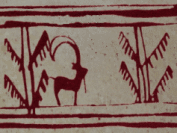Since 1979 Ibex has been committed to
publishing works which introduce the best of the Persian language,
literature, culture and history to the world.
We are an independent press located
in the Washington DC area. Our titles vary from those mainly of
interest to the scholar to those friendly to the general layman.
We publish in both English and
Persian. Mainly because of the assimilation of the Iranian population
outside of Iran, we are publishing more English titles in recent years.
Along the years we have published reference books, textbooks for the
study of Persian and other Middle-Eastern languages, autobiographies of
notable Iranians and many books in Persian which could not be published
in Iran. We have brought back to life E.G. Browne’s eternal Literary
History of Persian, the first (and many say best) comprehensive Persian
cookbook and Wilberforce-Clarke’s detailed and complete translation of
Hafez. We also distribute the books of the historically important
Harvard University Iranian Oral History Project and Farhang Moaser.
Volume six of the revealing diaries of Alam, “the Shah’s best friend,”
should be out later this year. We also have a soft spot for Hafez , the
most beloved poet of the land of poets. We have, so far, published four
diverse translations of his poetry. We have also published a few titles
that had literary merit outside of the main scope of our mission
including a translation of a prize winning novel from Haiti.
OUR STORE
We have a store, Iranbooks. If you
are in the Washington DC area, please visit the store. Iranbooks also
sell books from other publishers about Iran. You may visit their web
site: iranbooks.com
WHAT IS AN IBEX?
 The Ibex is a mountain goat found in Iran. It
resembles the animal in the logo we used before we chose the name Ibex
for our company. Ibex is also a phonetic play on the name Iranbooks.
The Ibex is a mountain goat found in Iran. It
resembles the animal in the logo we used before we chose the name Ibex
for our company. Ibex is also a phonetic play on the name Iranbooks.The Ibex is even found in the United
States. There are several hundred on the loose in Arizona. Apparently
two were given as a gift during Shah's time, somehow got into the wild,
and multiplied. The Persian for an ibex is pâzan or pâzhan. We have
used “Châp-e Pâzhan,” because it is short, sounds okay, and contains
three of the non-Arabic Persian letters cheh, peh and zheh.
Pre-historic animated ibexThe oldest
example of animation is apparently that of an ibex. A 5,200-year-old
bowl found in Iran’s Burnt City in the 1970s features a series of five
images that researchers have only recently identified as being
sequential, much like those in a zoetrope. Giving the bowl a spin, one
would see a goat leaping to snatch leaves from a tree, as seen in this
image.
The remarkable piece of pottery was
unearthed from a burial site by Italian archaeologists, who hadn’t
noticed the special relationship between the images that adorned the
circumference. That discovery was made years later by Iranian
archaeologist Dr. Mansur Sadjadi, who was later hired to direct the
excavation of The Burnt City, located 57 kilometers from the city of
Zabol in the southeastern Iranian province of Sistan-Baluchestan.
Mr. Mohammad Nasserifard has
collected photographs and information on Iranian petroglyphs, some over
40,000 years old. In ninety percent of them, the subjects are ibex.









